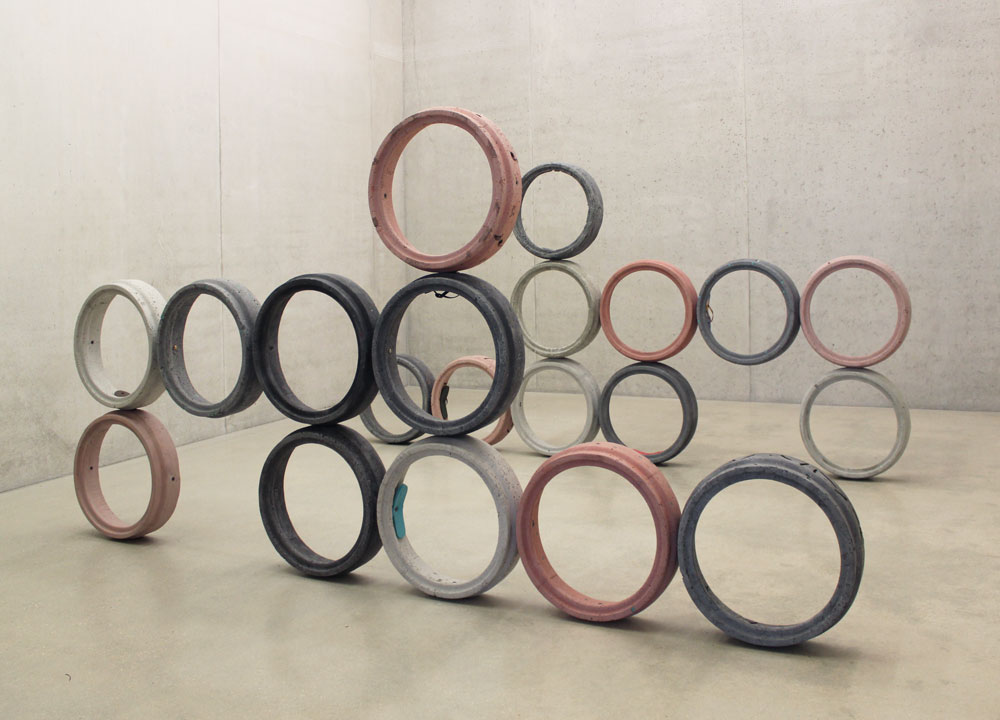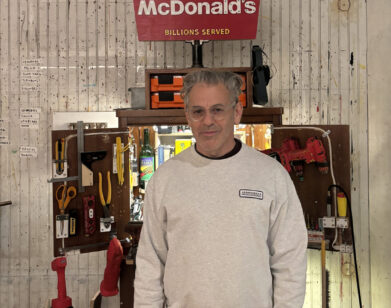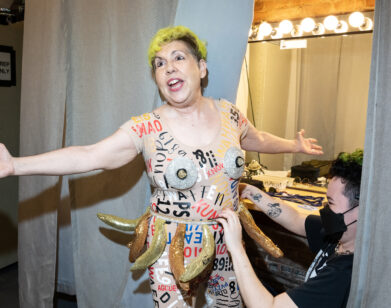Working Underwater
For his latest project, Miami-based artist Nicolas Lobo used a swimming pool as his studio. Over the course of four months, Lobo employed experimental techniques in order to cast three-dimensional concrete rings—which he interlocked for one cohesive sculpture—and create carbon fiber wall hangings. The result is an immersive, site-specific installation and exhibition, “The Leisure Pit,” which opens today at the Pérez Art Museum in Miami.
Lobo, in previous series, worked with materials ranging from grape-flavored cough syrup to Play-Doh, terrazzo, and Napalm, and his research- and process-based practice has focused on a variety of topics, including illicit pirate radio, illegal drug making locations, and the Go-Go dance scene. No matter the topic of discussion, however, one thing remains continuous: the artist’s attention to and fascination with the intersection and changing natures of cultures and consumption.
With this series, the artist uses the swimming pool as a point of contention, sparking conversations about the ways in which Miami has changed and the city’s ubiquitous sense of luxury. The image inscribed on the outer shell of the mold used to cast each ring assumes multiple identities—one might see the head of Medusa, the Versace logo, or an outsized pill representing a legendary strain of ecstasy—just like the city itself.
Soon after he finished casting the cement rings, we spoke with Lobo about the labor-intensive project over the phone.
EMILY MCDERMOTT: I’m really curious about the process. I’ve never heard of casting in a pool. Can you talk about where the idea came from?
NICOLAS LOBO: The whole project started with the process, and then the form emerged out of what was possible with the process. Pools are really interesting to me, but they’re also this thing that comes up with different artists’ work again and again—also writers, J.G. Ballard and stuff like that. For me, I wanted to deal with the pool but didn’t want to just show a pool or an image of a pool or a sculpture of a pool. I didn’t want to have the pool portrayed, so that’s how I ended up using the pool like a machine, or like an industrial vat, to produce the work. [With pools,] there’s this vat, and there’s all this machinery, but then it’s all kind of hidden and you’re supposed to be in this sparkling natural oasis. The last show I did was modeled after a rock garden, so I felt like it was interesting to deal with the pool this time because it’s another hyper-mediated natural thing.
MCDERMOTT: Are you talking about “Bad Soda / Soft Drunk”?
LOBO: Yeah, exactly. There was this Zen grid thing going on, and here it’s more like this sparkling clearing with a little spring in the middle. There’s this aesthetic that goes along with pool, and there are all these Greek ideas—you might have this hyper-modernist house, but then, by the pool, there’s this little Greek knock-off sculpture. It’s like the last little scrap of Greek kitsch.
Actually, the original germ of the idea is this really stupid story about this thing that happened here [in Miami] in the late ’50s. There’s this myth that the Bahamas were Atlantis; there’s conspiracy theories that it’s the imperial continent of Atlantis. In the late ’50s people claimed to have found Greek columns off the coast of Miami. What it ended up being was, in World War II, a supply ship had been in a storm and wooden barrels had fallen off. They were filled with concrete and landed and hardened underwater, and all of the wood rotted away, so you had these weird concrete columns sprouting up. Scuba divers found that and it started this media frenzy. Then they actually pulled one up and determined what it was. Doing research and reading about that was what sparked the idea of making something underwater.
MCDERMOTT: Was this idea specifically thought of for this show? Or had it been something you’d wanted to work on for a while?
LOBO: The idea had been percolating but it was in an earlier stage, and then when René [Morales], the curator, approached me about doing the show, I laid out a couple of ideas I’d been thinking about and we decided to focus on this one and develop it. It came a long way from the first conversation, but it was already there in the background being developed.
MCDERMOTT: So what about the wall pieces? Were they made underwater?
LOBO: [They’re] carbon fiber panels that have spandex stretched over them and then compressed using a pool pump, in the pool, and it makes these hyper-thin panels. They operate like painting, but they’re really sculptures—to me, they just happen to be flat and hung on the wall. You could take it as painting at first, but as you look at it, it really doesn’t go into a painting direction; it goes more into an architectural paneling direction. I feel like they coincide with the rings in this modular architectural way.
MCDERMOTT: The creation of everything was rather experimental. Was there a time where you just felt it was an epic failure and another time where you felt like “This is working out, this is what I should continue doing”?
LOBO: Pretty much every day, both of those feelings. The rings became like a modular experiment; each ring represents a distinct experiment in the pool. They’re all different. Some of them had food items cast into it and then went into a bath of chlorine and the chlorine ate away the food, and then you’re left with these fossils. I used French fries and jumbo shrimp. And then there’s other ones where I chip the tiles out of the pool and then cast those into the ring, so there’s rings that have all this pool tile on the surface. Some of the rings were cast outside of the pool using pool water and certain chemical agents that would react with the pool water and change the way it’s set up. So each one was it’s own little test tube, in a way.
One of the most spectacular failures that I had was [when] I mixed a pound of aluminum powder with eight pounds of concrete and pool water that was concentrated. I knew this was going to cause a reaction, which is why I did it, but I didn’t expect it to be so violent. I don’t know if you know, but aluminum and the chemicals in pool water don’t get along at all, and that was actually multiplied by what’s in the additives in the concrete. So basically, I got this big metallic explosion.
MCDERMOTT: That must have been a beautiful sight, but in a really terrifying way.
LOBO: I was scared for a second because it was really, really hot, and everything was metallic. It had this look of molten metal everywhere and it was fizzing over everywhere, so it turned into a giant metallic blob. I basically dumped it all onto a tarp and let it run its course and got away from it. It took about an hour to settle down. My idea was to make this bubbly metallic ring, but it just turned into an explosive situation.
MCDERMOTT: Did you try to make any columns like the scuba divers found?
LOBO: In the beginning there were other things that were planned. I was going to do something like that, but I had to really edit everything down to focus on what was working and what wasn’t, and that was going to be a side tangent.
MCDERMOTT: So why did you choose to focus on the rings, the circular notion?
LOBO: The rings are actually a distilled design from a storm drain. When I say storm drain, I mean these giant concrete things that they bury next to highways. There’s this engineering spec sheet, where they give you these instructions on how to make them. If you take the engineering drawings and slice off the exact part where the human goes in, that’s it, that’s what the rings are, the cross section.
MCDERMOTT: I know the connotation is supposed to be about the leisure of a swimming pool and its implications within the context of 21st century Miami. How do you think Miami has changed since you’ve lived there, and what do you think these implications have become?
LOBO: One thing that was tough, when I was developing the project with the curator, was this idea of ecological alarmism. I really didn’t want to focus on that with the work; I was interested in the actual conditions and didn’t want to take the stance of ecological alarmism. That’s one way people have taken some of the changes that are happening in Miami—there’s this, “We’re all rethinking how to think.” One thought that’s bubbled up to the surface in the last 10 years—there’s a huge population explosion, it’s not being done in a very organized way, and it allows for very interesting situations.
The whole pool thing, for example, there’s this pool hierarchy. We have these pools and they don’t age well, so a 20-year-old pool is barley usable. When they crack or go bad, it’s too expensive to remove them, so people just poor a concrete cap over them. So, houses and older motels, they just have this capped-off pool sitting in the center; it’s like a courtyard, but a little sketchy because it’s this capped-off pool. I think the city is really starting to show it’s age [and] it’s aging in a hyper-accelerated way because it’s growing so fast. Even though it’s basically 100-and-some-odd years old, it’s falling apart.
MCDERMOTT: That’s where you get into dealing with the infrastructure, which I know is another key issue that you deal with in your work.
LOBO: But the infrastructure that I’m interested in is the part that intersects with humans, where humans have to deal with it. Infrastructure for it’s own sake I’m not that interested in. Where humans have to deal with infrastructure that’s not really designed for them, I think that’s interesting.
MCDERMOTT: I also know you wanted to convey the disruption of the separation between labor and leisure, and production and function, and public and private. Is there a more specific aspect of those themes that you want to deal with?
LOBO: I’m really interested in luxury and the way it was dealt with here. I feel like Miami is this place for the $100,000 millionaire, so everything is luxurious and overwrought because it’s this vacation fantasy. Everyone comes down here and has this luxury fantasy, no matter how much money they have. I think the city is a lot about maintaining that. It’s not a resort city anymore, it’s a city that does other things, but there’s this undercurrent of luxury lifestyle.
MCDERMOTT: Can you speak about the Medusa head and Versace logo that represent a specific strain of ecstasy that you used?
LOBO: It’s called the mother mold of the molds for the rings. I was really interested in it because it is kind of slippery; it could be a lot of things. It’s the Versace logo, but it’s also this giant ecstasy pill. When I was developing the show, I had a lot of different ideas about the garden statuary subjects, or things that you find by the pool, and how to deal with that. Of all of the things, that seemed like it made the most sense, because it was so slippery. It’s a fashion logo, but it’s also an ecstasy pill, and it’s also based on a bunch of imperial Greek sculptures, and at the same time it looks like it belongs next to the pool, or on the house next to the pool. It’s hard to pin down.
MCDERMOTT: It’s also very dependent upon where the visitor is coming from. If somebody lives in Miami they’re going to get something totally different from this than someone who lives in New York or someone who lives in Idaho.
LOBO: Yeah, totally. Miami is probably one of the most heavily coated in stereotypes of any place. There are all these marketing images that are associated with Miami, so I wanted to deal with that in a way that I hoped would be different and original.
“THE LEISURE PIT” OPENS TODAY, APRIL 16, AT THE PEREZ ART MUSEUM IN MIAMI AND WILL BE ON VIEW THROUGH DECEMBER 13.







